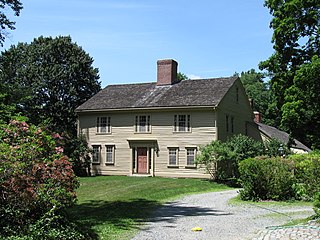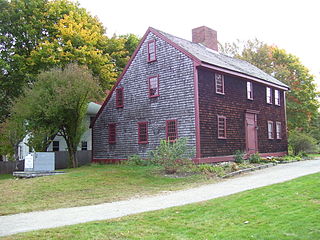
Estey Organ Company was an organ manufacturer located in the United States. The company, based in Brattleboro, Vermont, was founded in 1852 by Jacob Estey, who bought out another Brattleboro manufacturing business. At its peak, the company was one of the world's largest organ manufacturers, employed approximately 700 people, and sold its high-quality items as far away as Africa, Great Britain, Australia, and New Zealand. Estey built around 500,000 to 520,000 pump organs between 1846 and 1955. Estey also produced pianos, made at the Estey Piano Company Factory in New York City.

Estey Hall is a historic building on the campus of Shaw University in Raleigh, North Carolina. It was the second building constructed for the higher education of African-American women in the United States. Built in 1873, Estey Hall is the oldest surviving building at Shaw, which is the second oldest historically black college in the South and was the second institution of higher learning established for freedmen after the Civil War. The building, originally known as "Estey Seminary," was named in honor of Jacob Estey, the largest donor to the construction project. Estey Hall, located in the East Raleigh-South Park Historic District, was listed on the National Register of Historic Places in 1973 and is a Raleigh Historic Landmark.

Hall Tavern is an historic tavern at 20 Gray Gardens West Street in Cambridge, Massachusetts. Now converted to residential use, this two story Federal style wood frame building was built in sometime in the late 1790s in Duxbury, Massachusetts, and was moved to this location in 1930. The building is one of a number that were moved in order to preserve them in the early decades of the 20th century, and it is now one of the centerpieces of the Gray Gardens subdivision.

The Parkman Tavern is an historic tavern at 20 Powder Mill Road in Concord, Massachusetts. It is a 2 1⁄2-story timber-frame structure, five bays wide, with a side-gable roof, large central chimney, and clapboard siding. It is estimated to have been built in the late 17th or early 18th century, by a member of the locally prominent Wheeler family. In the late 18th century it was purchased by William Parkman, great-uncle to historian Francis Parkman, who operated a tavern on the premises.

Simonds Tavern is an historic tavern building in Lexington, Massachusetts. It is a 2-1/2 story wood frame structure, eight bays wide, with two front entrances and asymmetrically placed chimneys. The first portion of the building was built c. 1794 by Joshua Simonds, who also ran a tavern near Fiske Hill. He began operating a tavern at this site in 1802, and enlarged the building 1810 after Bedford Street was cut through the area. The building's interior has well-preserved Federal details.

The Rider Tavern is an historic tavern on Stafford Street in the Northside Village Historic District of Charlton, Massachusetts. The tavern, now a large three story wood frame building, was built c. 1797, and was for many years an important stop on the stagecoach road. It is owned by the Charlton Historical Society, and open for guided tours in the summer and special events.

The Parker Tavern is a historic house museum in Reading, Massachusetts, United States. Built in 1694, it is the oldest extant structure in Reading. The saltbox was built by Abraham Bryant, a farmer and blacksmith, and Ephraim Parker operated a tavern on the premises in the 18th century. It has been a local history museum since 1923, and was listed on the National Register of Historic Places in 1975.

The Briggs Tavern is a historic building at 2 Anawan Street in Rehoboth, Massachusetts. Built about 1780 and now used as a private residence, it is the town's only surviving 18th-century commercial building. It was listed on the National Register of Historic Places in 1983.

The Roebuck Tavern is a historic tavern at 21 Dedham Street in Wrentham, Massachusetts. The two-story Federal style structure was built in 1795 by David Fisher, whose family was one of the earliest to settle the area in the 17th century. Fisher operated a tavern, which would have been successful, as Wrentham was then a stop on the stagecoach route between Boston and Providence, Rhode Island. The building remained in the Fisher family until 1910.

The Bigelow Tavern Historic District is a historic district in West Boylston, Massachusetts. It consists of a cluster of three buildings: Bigelow Tavern, the White/Gibbs Store, and Temple's Distillery. The buildings have a history of common ownership, and the area was locally important from the late 18th century into the late 19th century. The district was added to the National Register of Historic Places in 1992.

The Merrell Tavern, known more recently as the Merrell Inn, is a historic tavern at 1565 Pleasant Street in South Lee, Massachusetts. Built in 1794 as a residence, it has served for most of two centuries as a local traveler's accommodation, and retains fine Federal period architectural details. > It was added to the National Register of Historic Places in 1972. It continues to serve its historic function, and is now operated as a bed and breakfast inn.

Jones Tavern is a historic tavern at 128 Main Street in Acton, Massachusetts.

The Capt. Nathaniel Parker Red House is a historic house at 77–83 Ash Street in Reading, Massachusetts. It is a 2 1⁄2-story vernacular Georgian house, five bays wide, with entrances on its north and south facades. The southern entry is slightly more elegant, with flanking pilasters and a transom window. The house was built sometime before 1755, and was already a well-known landmark because it was painted, and served as a tavern on the coach road. The Tavern served as a meeting place for many revolutionaries and minute men, notably Marquis de Lafayette, and Alexander Hamilton. The house remained in the hands of militia captain Nathaniel Parker and his descendants into the late 19th century. The construction of the Andover Turnpike in 1806–07, bypassing its location, prompted a decline in the tavern's business.

The Jerry Nichols Tavern is an historic house in Reading, Massachusetts. It is a 2 1⁄2-storey wood-frame structure, five bays wide, with a side gable roof, central chimney, and clapboard siding. The main entrance is flanked by pilasters and topped by an entablature. The oldest portion of the house was built in 1785 by Jeremiah Nichols, a Revolutionary War veteran, farmer, and shoemaker. This property was where Reading's minute companies drilled prior to the American Revolutionary War, and where its powder magazine was kept. The building was expanded 1810–13, and had by 1830 been adapted as a tavern and stage coach stop. In 1824 it was bought by Rev. Peter Sanborn, in whose family it remained into the 1940s.

Ware's Tavern is a historic tavern in Sherborn, Massachusetts. The two story wood frame structure was built c. 1780 by Benjamin Ware as a house for his family. It has a centered entry that is now sheltered by a Colonial Revival surround. Ware's son Eleazer converted the building into a tavern; it was greatly enlarged with an ell to the rear c. 1840. The building ceased to be used as a tavern by 1889; an ell was removed sometime in the 19th century, and now stands at 109 S. Main Street.

Stearns Tavern is a historic tavern in Worcester, Massachusetts. The building is one of the best extant examples of vernacular Federal style architecture in the city. Its construction is dated to c. 1812 based on 19th-century historical sources, and it was suggested that its frame may be even older, based on analysis conducted during a 1974 move of the building. The building is a two-story timber-frame house, with a two-story ell on the northeast. The front door is a distinctive six-panel door, flanked by sidelights and topped by a fanlight. Originally located at 1030 Main Street, it was moved in 1974 to 651 Park Avenue and converted for use as a bank. Restoration done at the time exposed Federal style details that had been covered over in the intervening years. It was located at 651 Park Avenue in Worcester, Massachusetts from 1974 to 2016.

Whittemore's Tavern is a historic building at 473 Auburn Street in the Auburndale village of Newton, Massachusetts. It was operated as a tavern for a time in the 18th century, but it is now a private residence. The 2-1/2 story wood frame house was built c. 1724, probably by William Robinson II, sone of one of Auburndale's early settlers. It served as a tavern in the 1760s, when Auburn Street was a major east–west thoroughfare. The asymmetrical window placement on the front facade suggests that the house may have been built in stages.

The Canton Corner Historic District is a historic district encompassing the historic town center of Canton, Massachusetts. Centered on the junction of Pleasant and Washington Streets, it includes more than 25 properties and 170 acres (69 ha), whose architectural history spans 250 years of occupation and include the town's major civic buildings. The district was added to the National Register of Historic Places on September 9, 2009.





















